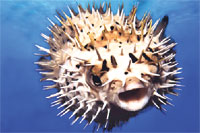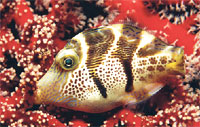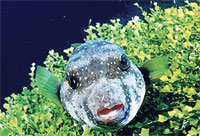Pufferfish are able to inflate into a ball shape to evade
predators. Also known as blowfish, these clumsy swimmers fill their elastic stomachs with huge amounts of water (and sometimes air) and can blow themselves up to
several times their normal size. Some species also have spines on their skin to ward off predators.
Even if a predator
gobbles up a puffer before it inflates, it won't enjoy the snack. Most pufferfish contain a toxic substance that makes them foul
tasting and potentially deadly to other fish. The toxin is deadly to humans.
There is enough poison in one pufferfish to kill 30 adult humans, and there is no known antidote.
In Japan, they are called fugu and are a very
expensive, delicious treat. Because the fish are so poisonous, they are prepared only by trained, licensed fugu chefs.
One false cut by the chef can mean death for the
consumer.
Most puffers are found in tropical and subtropical ocean water, but some species live in brackish and even fresh water. They have long, tapered bodies with bulbous heads.
Some have wild markings and colours to show off their toxicity, while others have more muted colouring to blend in with the
environment.
They are scaleless fish and usually have rough or spiky skin. All have four teeth that are fused
together into a beak-like form.
Pufferfish eat
mostly
invertebrates and algae. Large puffers will even crack open and eat clams, mussels and
shellfish with their hard beaks.
Some species of
pufferfish are considered vulnerable due to
pollution, habitat loss and overfishing, but most
populations are considered stable.
Fast Facts:
- Pufferfish are in the family Tetraodontidae, which means four teeth. The teeth are fused together and are used to crush their prey.
- There are more than 120 species of
pufferfish worldwide.
- Pufferfish can be up to three feet (one metre) long.
|



